Portsmouth and Roanoke (Seaboard and Roanoke) Railroad
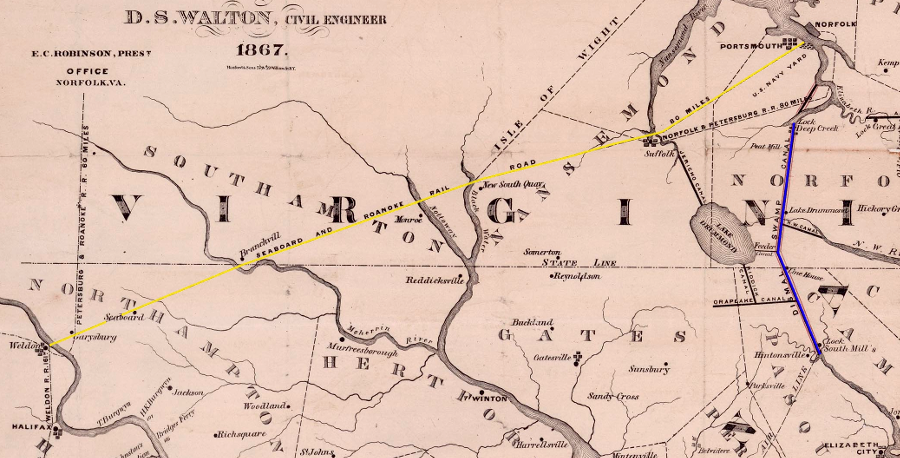
the Portsmouth and Roanoke Railroad (yellow line) improved upon the transportation already provided by the Dismal Swamp Canal (blue line) between the Roanoke River and the Chesapeake Bay
Source: University of North Carolina - Learn NC, Map of the Dismal Swamp Canal (by D. S. Walton, 1867)
The Portsmouth and Roanoke Railroad was chartered on March 8, 1832.
Track was built from Chestnut and High Street in Portsmouth southwest, with the line reaching Suffolk in 1834. The line was completed to the eastern bank of the Roanoke River at Blakely's Depot (later Garysburg), North Carolina in 1836. A bridge across the river to Weldon opened in 1837. In Portsmouth, track was run from the original terminal to the Elizabeth River wharf in 1838.
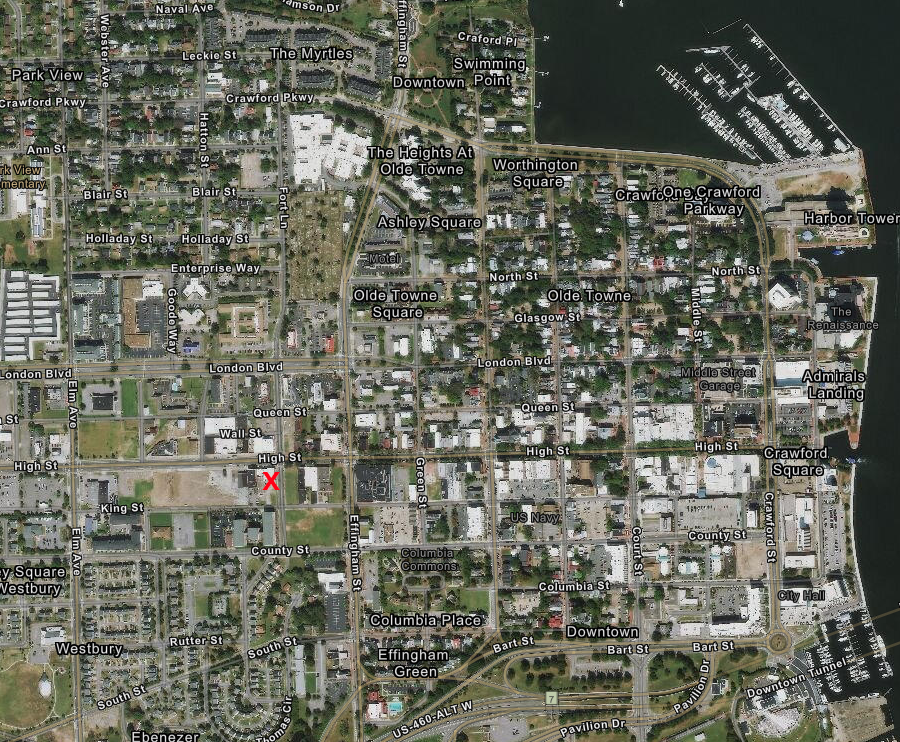
the first Portsmouth and Roanoke Railroad terminal was at Chestnut and High Street (red X)
Source: ESRI, ArcGIS Online
After a tempestuous nine years, it was renamed the Seaboard and Roanoke Railroad when it emerged from bankruptcy in 1846 under ownership of Virginia's Bureau of Public Works.
The Seaboard and Roanoke Railroad was added to the Seaboard Air Line as an alliance among various railroads in 1881, and incorporated into that company formally in 1900. The Seaboard Air Line merged with the Atlantic Coast Line Railroad in 1967 to create the Seaboard Coast Line. In 1986, it became a part of the CSX Transportation Company.1
The original justification for building the Portsmouth and Roanoke Railroad in the 1830's was to reduce the high costs of transporting agricultural products from the Piedmont to an international port in the Chesapeake Bay watershed, either Petersburg or Portsmouth.
Shipping tobacco, lumber, wheat, and other products down the Roanoke River was less expensive and required less time than hauling products over plank and mud roads to Petersburg. Those roads were often unusable. Though less expensive than hauling crops by wagon over poor roads, water transport via the Blackwater River, Nottoway River, Meherrin River, or Roanoke River also cost too much. Farmers saw most of their potential profits being consumed by transport to market.
While floating goods downstream via the Roanoke River avoided the roads, that river emptied into Albemarle Sound where shallow channels through barrier islands of the Outer Banks made it difficult for ocean-going ships to navigate. On the North Carolina coast north of Wilmington, there were no major ports. Far more ships sailed into the Chesapeake Bay, creating a higher demand and higher prices for goods that were brought to wharves at various ports in that watershed.
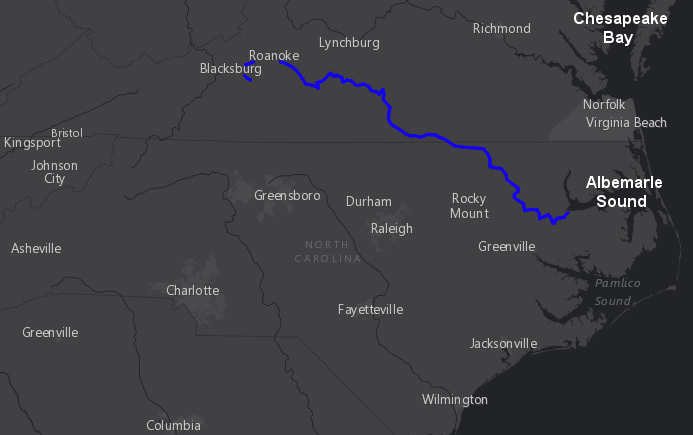
the Roanoke River flows to Albemarle Sound, but in the 1800's the ports with the most traffic and best prices were on the Chesapeake Bay
Source: ESRI, ArcGIS Online
Farmers in the Roanoke River watershed and merchants in southeastern Virginia shared a common objective. Both wanted to improve transportation between the Roanoke River and the Chesapeake Bay in order to lower costs and increase profits.
There were multiple government subsidized projects to improve water transport, even after railroads became more cost-effective. The Dismal Swamp Canal provided water access from Albemarle Sound to the Elizabeth River. By 1815, flour from mills in Southside Virginia could travel by boat to Norfolk down the Roanoke River and up the Dismal Swamp Canal.
In 1828, the rapids in the Roanoke River were altered and the canal improved by the US Army Corps of Engineers and the Roanoke Navigation Company. Portsmouth and Norfolk became major destinations for tobacco and other agricultural products. The quantity of crops produced in the Roanoke River watershed exceded local and even regional demand. Wheat, flour, tobacco, and other items were shipped to New York, Charleston, or even cities in Europe.
The success of the Hampton Roads ports drew business away from the Fall Line ports of Richmond and Petersburg. Hampton Roads ports were closer to the Atlantic Ocean, so no long trips were required to sail to ports upstream on the James, York, Rappahannock and Potomac rivers. Ships could make more trips, and earn more money, by loading cargo at wharves on the Elizabeth River.
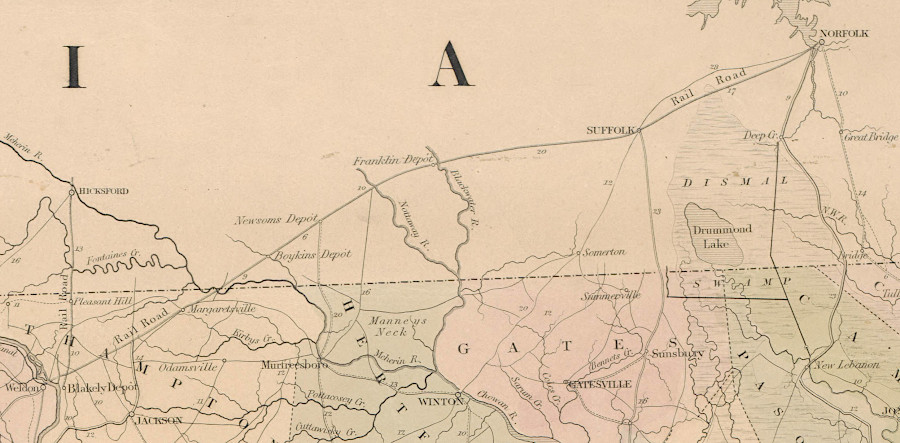
the Portsmouth and Roanoke Railroad provided a faster link than the Dismal Swamp Canal to the Chesapeake Bay
Source: University of North Carolina, Map of North and South Carolina exhibiting the post offices, post roads, canals, rail roads, &c. (by David H. Burr, 1839)
The new technology of railroads gave Petersburg the opportunity to compete with Portsmouth/Norfolk. Crops grown in the Piedmont could reach Petersburg's wharves faster via railroad than via slow canal boats traveling to Portsmouth/Norfolk.
Between 1830-33, investors based in Petersburg built the Petersburg Railroad south to the Roanoke River near Weldon, North Carolina. That track intercepted the river traffic on the north bank at Blakeley Depot, south of Garysburgh and across the river from Weldon. The Petersburg Railroad offered a faster alternative than floating cargo the extra distance to the Dismal Swamp Canal, then going north to Portsmouth or Norfolk.2
In a competitive response to construction of the Petersburg Railroad, Hampton Roads merchants obtained a charter from the Virginia and North Carolina General Assemblies for the Portsmouth and Roanoke Railroad to Weldon. The rail connection, 79 miles long from Portsmouth-Weldon, was intended to eliminate the roundabout trip down to the Chowan River and up the Dismal Swamp Canal. By building their own Portsmouth and Roanoke Railroad, Hampton Roads merchants also reduced costs and sped up the delivery of freight.
The volume of agricultural traffic was limited. Shipping cargo by rail from Weldon to Portsmouth would spur business in southeastern Virginia and reduce business at Petersburg; the railroad investors were competing in a zero-sum game where one city's gain in traffic was another city's loss. The Portsmouth and Roanoke Railroad was designed to provide jobs for laborers at Portsmouth's docks on the Elizabeth River, not at docks in Petersburg on the Appomattox River.
Norfolk business leaders considered financing a different railroad to the Tar River, but not until 1890 could thy attract the necessary investment to build what became the Norfolk & Carolina Railroad. Members of the Virginia General Assembly, allied with Petersburg, initially blocked approval of a charter for the Portsmouth and Roanoke Railroad in 1832. Construction was authorized a year later in the 1833 session of the legislature.3
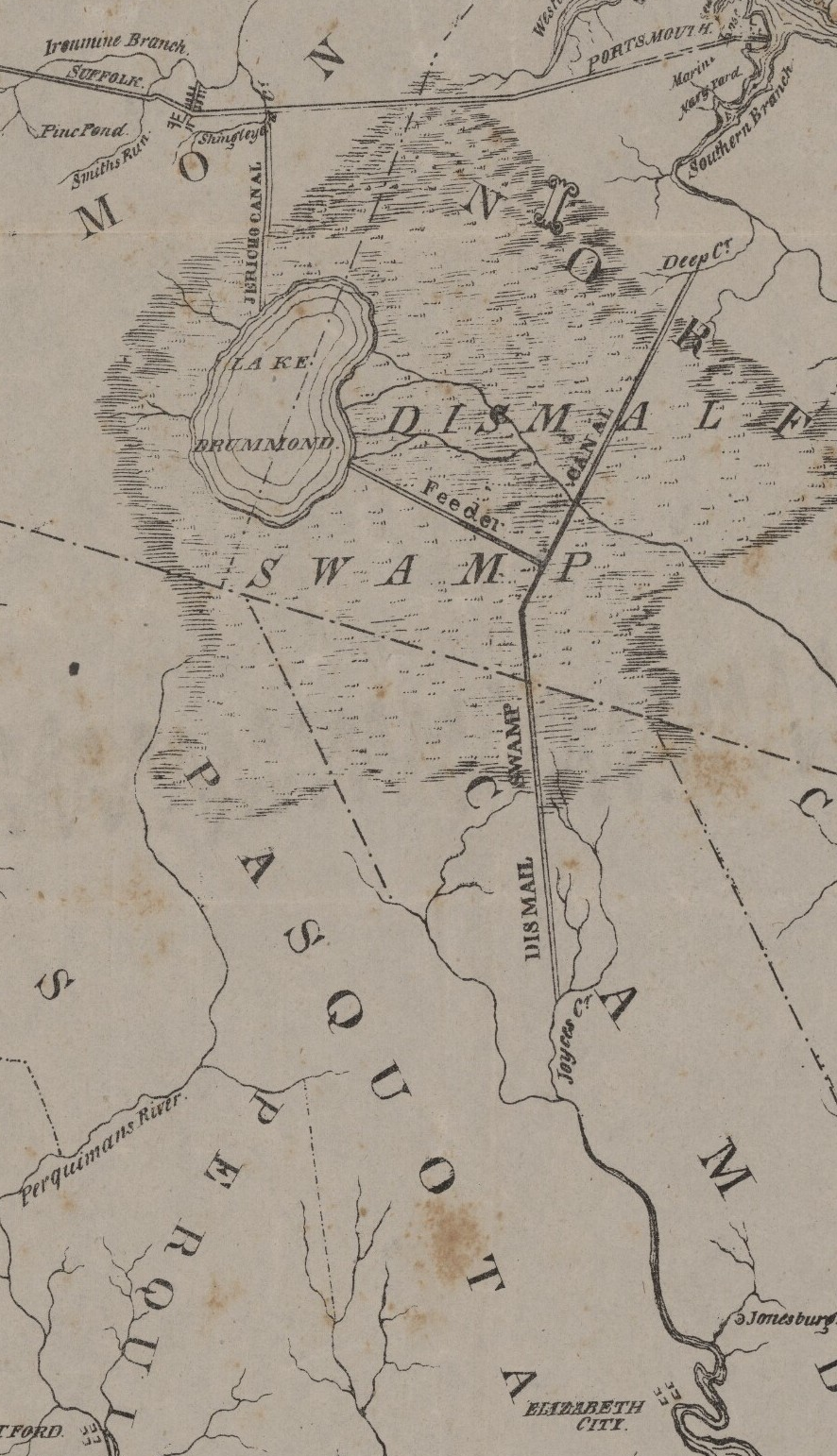
the Portsmouth and Roanoke Railroad was completed in 1837, intercepting boats on the Roanoke River upstream of the Dismal Swamp Canal
Source: University of Virginia Library, Plan of the Portsmouth & Roanoke Rail-Road and Trace of the Petersburg Rail Road (by Thos. H. Williamson, c.1835-1840)
The Portsmouth and Roanoke Railroad started on the west end of town. At the original terminal, wagons carried freight eastward on High Street to the Elizabeth River wharf in the center of town, north of the Gosport Navy Shipyard (now called the Norfolk Naval Shipyard). A few years later, the track was extended all the way to the wharf.
The Norfolk and Carolina Railroad and then the Atlantic Coast Line constructed piers further north (downstream) on the Elizabeth River at Pinners Point. The Atlantic and Danville Railroad built its terminal even further downstream, across Western Branch at Port Norfolk.
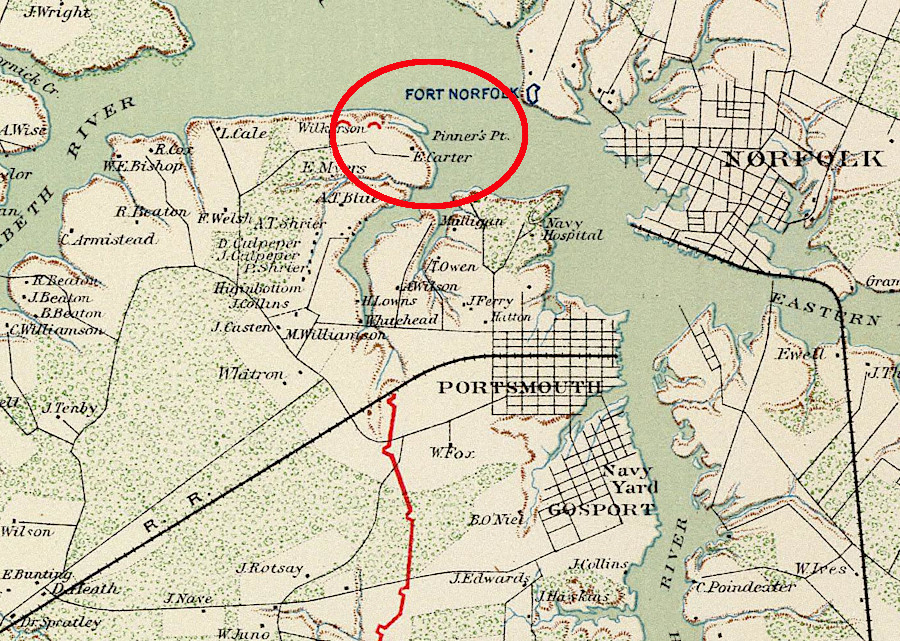
the Seaboard and Roanoke Railroad docks were in downtown Portsmouth during the Civil War, but later railroads built to Pinners Point
Source: David Rumsey Historical Map Collection, Suffolk & vicinity (Atlas to accompany the official records of the Union and Confederate armies, 1895)
The site of the original wharf for the Portsmouth and Roanoke Railroad is now part of downtown Portsmouth; only the small ferry shuttling passengers to Waterside at Norfolk is scheduled to stop there. Pinners Point has become the Portsmouth Marine Terminal (PMT), and is still served by CSX and the Norfolk and Portsmouth Belt Line.
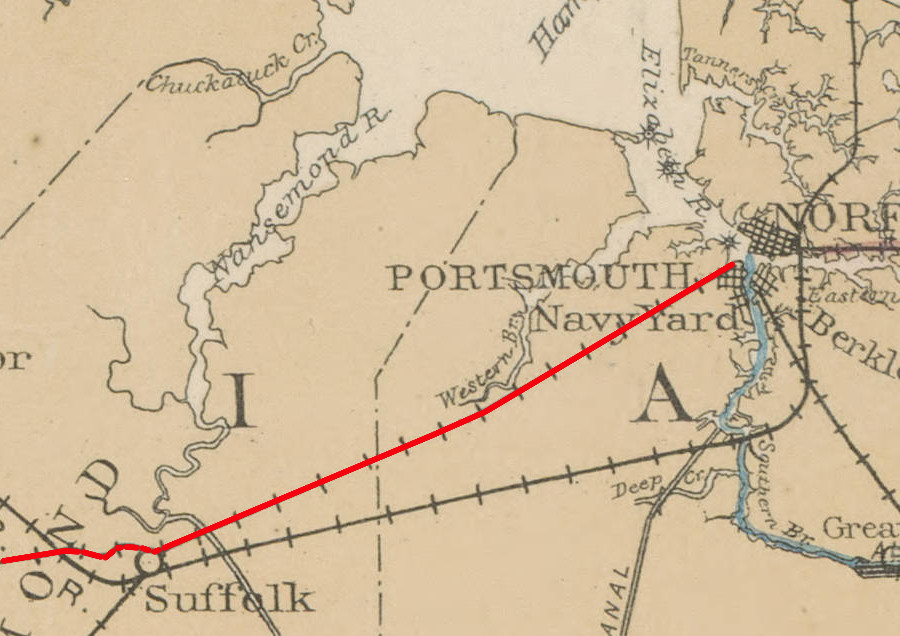
the Portsmouth and Roanoke Railroad built its shipping piers on the Elizabeth River near the Gosport Navy Shipyard
Source: University of North Carolina, Map of the Albemarle and Chesapeake Canal: connecting Chesapeake Bay with Currituck, Albemarle and Pamplico sounds and their tributary streams (by A. Lindenkohl and Henry Lindenkohl, 1885)
The Portsmouth and Roanoke Railroad reached Suffolk in 1834. As construction continued further to the southwest, the route cut straight through the tree-covered swamps southwest of Suffolk. That route opened up new territory for transporting lumber and cedar shakes that previously had been shipped via canals and ditches in the Great Dismal Swamp. Wood products generated traffic on the new railroad even before it reached the Roanoke River.
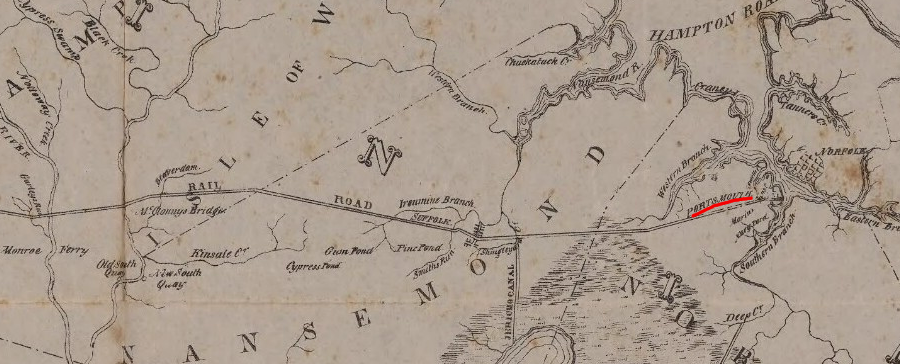
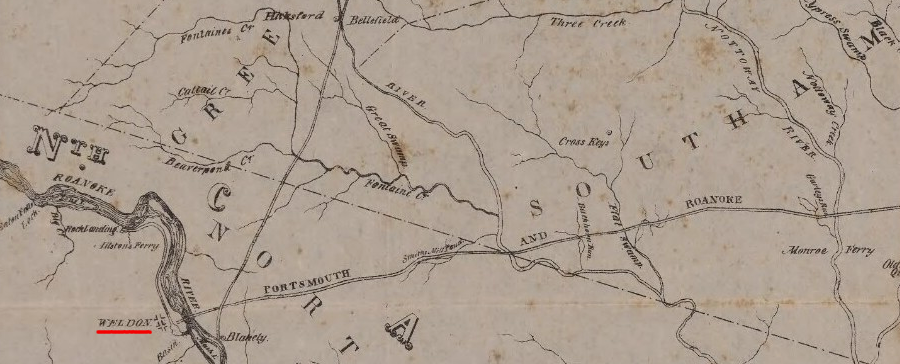
the Portsmouth and Roanoke Railroad connected a port on the Chesapeake Bay at Portsmouth with trade on the Roanoke River at Weldon
Source: University of Virginia Library, Plan of the Portsmouth & Roanoke Rail-Road and Trace of the Petersburg Rail Road (by Thos. H. Williamson, c.1835-1840)
To construct the track through the swamps, workers dug a ditch along the route and piled the excavated soil and a foot of additional sand on the roadbed. Railroad ties were buried in the soil to create an easy path for horses to pull the rail cars loaded with cargo and passengers. Track was a wooden timber with a strap of iron on top, providing a solid surface for the wheels of the railroad cars.
The first steam locomotive arrived in 1834, replacing the horses. The steam engine could pull a train at 15 miles/hour, and made two round trips daily between Suffolk and Portsmouth. A second locomotive was placed in service in 1835, the year the railroad bridged the Nottoway and Meherrin rivers.
In 1836, the Portsmouth and Roanoke Railroad built a bridge to cross over the Petersburg Railroad tracks at Blakely's Depot (Garysburgh), two miles northeast of Weldon.
The last stage of construction was to borrow enough money and negotiate the right to build tracks on the Weldon Toll Bridge across the Roanoke River. Widening that bridge to carry the rails, and construction of track from Garysburgh to the south bank of the Roanoke River, completed the 17 miles of track within North Carolina.
The Portsmouth and Roanoke Railroad was a rival, not a cooperative partner, with the Petersburg Railroad. The owners of the Weldon Toll Bridge convinced the North Carolina legislature to refuse the Petersburg Railroad's request for authorization to build its own bridge across the Roanoke River.
The Petersburg Railroad did get state authorization to build a new branch line, the Greensville and Roanoke Railroad. The Virginia legislature chartered it from Hicksford (Emporia) to the state border. The North Carolina legislature authorized construction from the Virginia line south to the upstream end of the Roanoke Canal at Wilkins Ferry (Gaston), located upstream of the Fall Line rapids at Weldon. In 1840 it connected there to the Raleigh and Gaston Railroad.
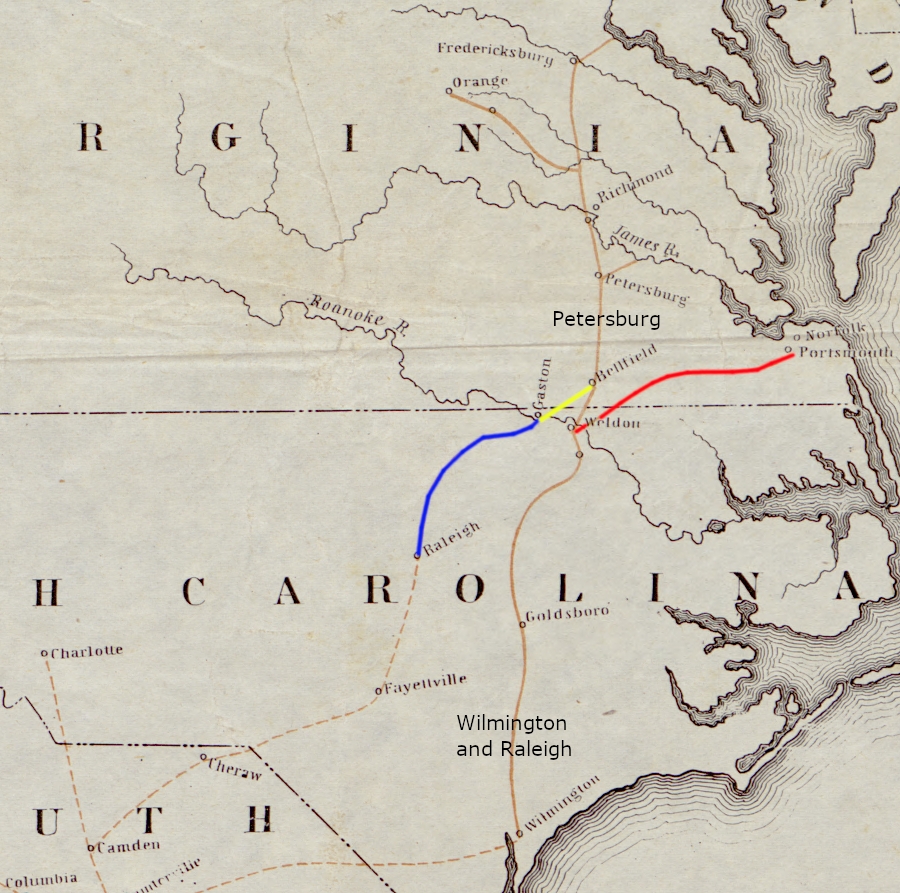
the Raleigh and Gaston Railroad (blue) connected to the Greensville and Roanoke Railroad (yellow) in 1840, and extended track to meet the Seaboard and Roanoke Railroad (red) in 1853
Source: Library of Congress, Skeleton map showing the Rail Roads completed and in progress in the United States (1848)
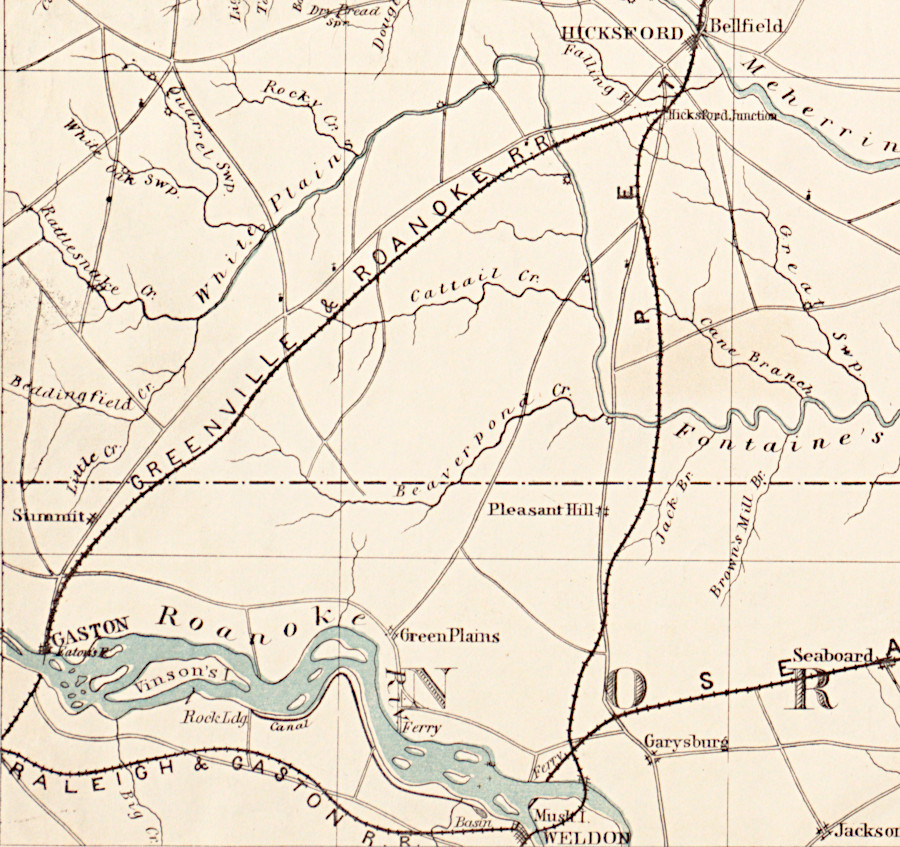
Greensville and Roanoke Railroad in 1862
Source: Norman B. Leventhal Map & Education Center Collection, Military map of south-eastern Virginia (c.1862)
The Petersburg Railroad and the Portsmouth and Roanoke Railroad moved agricultural products grown in North Carolina to ports located in Virginia. Diverting trade to the Chesapeake Bay watershed was a threat to the growth of Wilmington, North Carolina's major port.
Wilmington was not blocked physically by the barrier islands, unlike cities on Albemarle Sound, but it lacked the inland infrastructure to move crops to the coast. Virginians built two railroads and the Dismal Swamp Canal, diverting North Carolina trade to a rival state.
Wilmington's response was to construct the Wilmington & Raleigh Railroad. The state of North Carolina bought 40% of its stock to provide funds for construction.
Despite its name, that track ended up running from Wilmington to Weldon, not to Raleigh. It crossed the Neuse River at Waynesborough (which became Goldsborough's Junction, now Goldsboro) and connected to the Portsmouth and Roanoke Railroad at Weldon in 1840. The mis-labelled railroad finally was renamed the Wilmington and Weldon Railroad in 1855.
Much later, the legislature facilitated construction of track that connected the interior of North Carolina to the coast before the Civil War. The North Carolina Railroad was built between Charlotte and Goldsboro in 1856. Completion of the Atlantic & North Carolina Railroad in 1858, from Goldsboro to Beaufort, created a network that finally provided railroad connections from the eastern base of the Blue Ridge to both of North Carolina's port cities.4
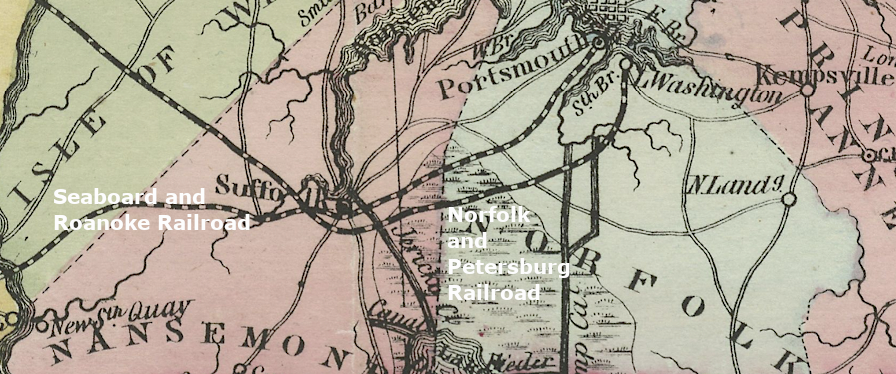
at the start of the Civil War, two railroads connected to Hampton Roads
Source: Library of Virginia, Map of the state of Virginia containing the counties, principal towns, railroads, rivers, canals & all other internal improvements (Ludwig von Buchholtz, 1858)

railroads connected Raleigh and Virginia ports before the start of the Civil War
Source: Norman B. Leventhal Map & Education Center Collection, Middle Virginia and North Carolina (1864)
Merchants in Norfolk and Portsmouth understood the value of diverting more North Carolina trade to the Elizabeth River. They financed most of the Portsmouth and Roanoke Railroad, buying 60% of its stock. The Virginia Board of Public Works purchased the other 40% of the stock, which was the state's standard share of financial support for railroads chartered by the General Assembly prior to the Civil War.
The merchants in Petersburg and Richmond were threatened by the new railroad to Portsmouth. They did not view growth of Hampton Roads ports as part of a statewide competition of Virginia with Maryland, and its port at Baltimore. Instead, they viewed the Portsmouth and Roanoke Railroad as a sectional rival. It diverted cotton, tobacco, and other goods from the Roanoke River to Portsmouth. That reduced business activity in Petersburg and Richmond.
The Fall Line cities of Petersburg and Richmond had one major advantage for attracting the tobacco being floated down the Roanoke River. Factories that relied upon waterpower created a stable market, always purchasing tobacco as a "raw material" and processing it into pipe and chewing tobacco products. To supply that steady demand, most tobacco continued to go north on the Petersburg Railroad. However, the completion of the Portsmouth and Roanoke Railroad created competition for the tobacco exported to Europe.
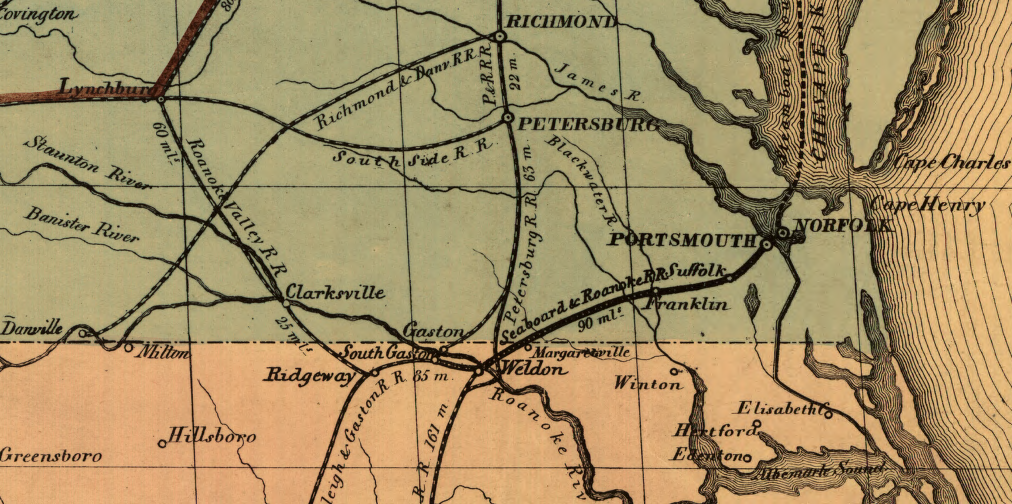
in 1851, only the Portsmouth and Roanoke Railroad connected the Roanoke River trade to Portsmouth
Source: Library of Congress, General map of the Orange & Alexandria Rail Road and its connections north, south, and west. (1851)
In the game of attracting the Roanoke River traffic, Petersburg made the next move. In 1837 the Petersburg Railroad built an extension southwest from Hicksford (which later merged with Belfield to form Emporia) to the Roanoke River at Wilkin's Ferry, North Carolina. That extension was managed as the Greensville & Roanoke Railroad. Wilkin's Ferry was renamed Gaston, then Old Gaston, and is now Thelma, North Carolina. (Modern Gaston is located north of the Roanoke River.)
The Greensville & Roanoke Railroad provided the Petersburg Railroad a chance to shift cargo from boats to railcars at a spot upstream from the rival Portsmouth and Roanoke Railroad landing at Weldon. The rival Petersburg Railroad facilitated construction of the Raleigh and Gaston Railroad, which bridged the Roanoke River and bypassed Weldon to provide a rail connection to Raleigh.
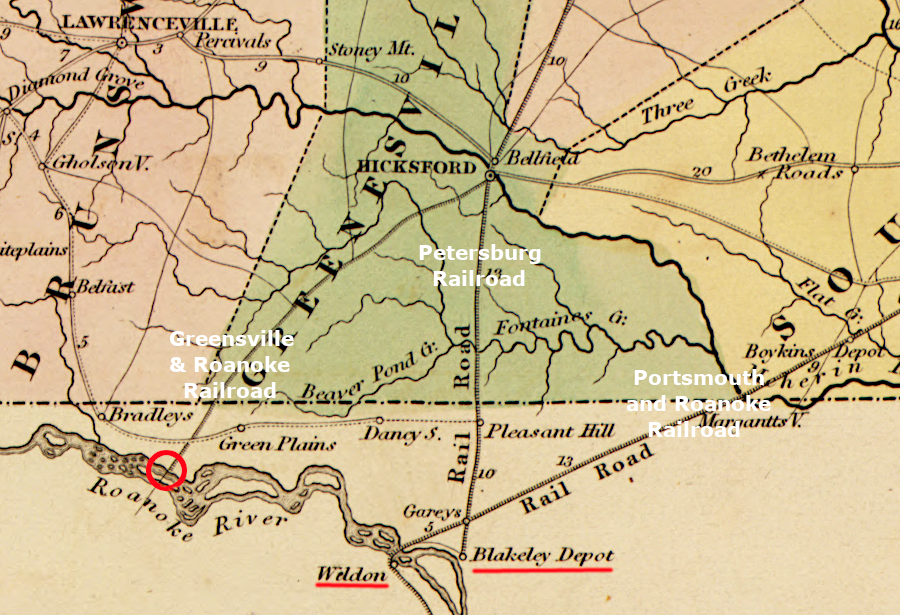
there were three railroad connections to the Roanoke River in 1839
Source: Library of Congress, The American atlas, exhibiting the post offices, post roads, rail roads, canals, and the physical & political divisions of the United States of North America (by John Arrowsmith, 1839)
The Petersburg Railroad also drove the Portsmouth and Roanoke Railroad into bankruptcy, to eliminate its competitor.
In 1843, the Petersburg Railroad arranged with the two independent railroad lines to its north, the Richmond and Petersburg Railroad and the Richmond, Fredericksburg and Potomac Railroad, to offer a joint fare with discounted prices for passengers traveling to Baltimore and points north. That "inland route" forced the rival Portsmouth and Roanoke Railroad to lower rates, reducing its revenue and the value of its bonds.
The Portsmouth and Roanoke Railroad responded by using steamships to provide an alternative to the Petersburg Railroad's inland route. The Portsmouth and Roanoke struck a deal with the Baltimore and Norfolk Steam Packet Company (the Bay Line) to offer competitive prices and schedules for transport to Baltimore.5
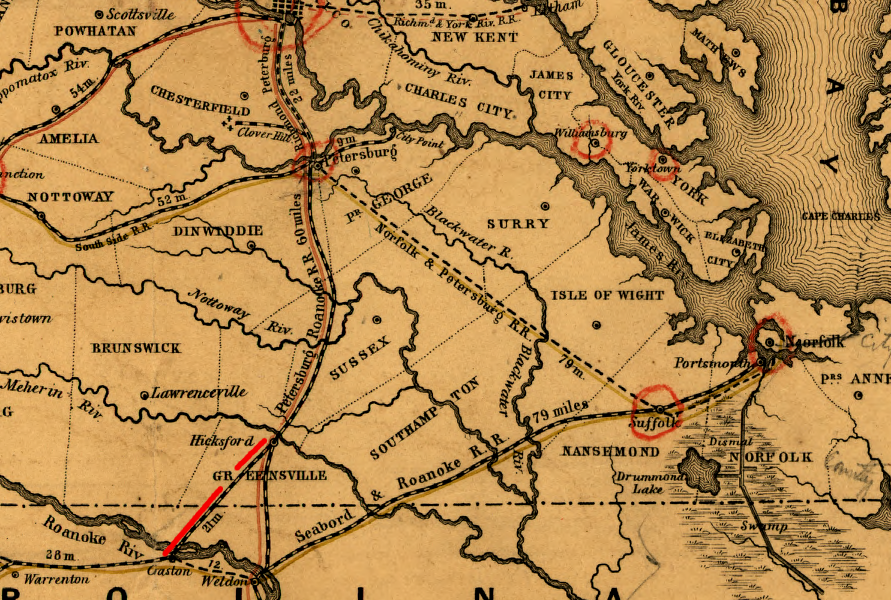
the Petersburg Railroad built a branch line from Hicksford (later part of Emporia) to the Roanoke River at Gaston (now Thelma, North Carolina)
Source: Library of Congress, Map of the proposed line of Rail Road connection between tide water Virginia and the Ohio River at Guyandotte, Parkersburg and Wheeling (1847)
The final challenge to the financially over-extended Portsmouth and Roanoke Railroad occurred when it went into bankruptcy in 1843. Business rivals in Petersburg bought the claims of the builder who had expanded the Weldon Toll Bridge, but had not yet been paid. The Petersburg rivals then bought at an auction the Weldon Toll Bridge and rails in North Carolina, and asserted ownership of the railroad. Late on January 6, 1844, a work crew began to remove rails from two miles of the Portsmouth and Roanoke Railroad in North Carolina northeast of the Roanoke River.
The intent was to sabotage the Portsmouth and Roanoke Railroad, intentionally blocking trains from running between Weldon and Portsmouth. Without the revenue from that business, the railroad could not make its scheduled debt payments and would have to close down. Portsmouth responded by sending a team of men into North Carolina to rebuilt the torn-up track.
Traffic was restored briefly, but the dispute ended up being settled in the courts. The North Carolina Supreme Court finally determined that the Petersburg-based owners could tear up the 17 miles of their own track within North Carolina. There was no requirement for them to operate the Portsmouth and Roanoke Railroad, though obviously the opportunity to generate revenue would be sacrificed. Though use of the tracks in North Carolina was blocked, the Portsmouth and Roanoke Railroad continued to operate from Portsmouth to the state line. From Margarettsville to Weldon, passengers and freight travelled by stagecoach and wagon.
To ensure the Portsmouth and Roanoke Railroad stayed out of service in North Carolina, Petersburg merchants made quarterly payments to the new owners of the railroad's debt. Those merchants calculated that, in the long run, profits from increased trade going to Petersburg (instead of Portsmouth) would be greater than the payments required to eliminate the competition.
Once traffic from North Carolina was interrupted on the Portsmouth and Roanoke Railroad, the Petersburg Railroad cancelled its discounted "through fare" arrangements with the Richmond and Petersburg Railroad and with the Richmond, Fredericksburg and Potomac Railroad. That increased revenues of the Petersburg Railroad. As planned, cutting the rail line from the Roanoke River to Portsmouth resulted in greater profits for the Petersburg Railroad and merchants in that city.
Petersburg's victory was short-lived. After defeating the competition in Portsmouth, the business and political leaders over-reached and tried to intercept Richmond's trade on the James River.
Petersburg built a canal to improve its connection to the James River via the Appomattox River, and then improved the City Point Railroad link to the James River. Petersburg also constructed the South Side Railroad to Lynchburg, which diverted the traffic going to Richmond via the James River and Kanawha Canal.
Richmond's merchants reacted to Petersburg's improved capacity. The Richmond and Petersburg Railroad, which was dominated by Richmond-based investors, had upgraded a branch line to Port Walthall and Bermuda Hundred on the James River, just upstream of its confluence with the Appomattox River, in 1840. That rail link had been built originally to carry coal from Chesterfield County mines to the James River, providing a shorter route and deeper water wharf compared to Manchester.
Port Walthall could draw business away from Petersburg. The natural shipping channel there was even deeper than the dredged channel at today's Richmond Marine Terminal (RMT).
In 1845, the Richmond-oriented railroads organized the Port Walthall Steamboat Company to carry passengers down the James River and ultimately up the Chesapeake Bay to Baltimore, directly competing with the efforts of the Petersburg Railroad to do the same.
Initially it was less important for the steamship line to make a profit than it was to cut into the revenue of the Petersburg Railroad. It quickly became clear that the Bay Line could make a healthy profit if the Weldon-Portsmouth railroad connection was re-established and business at Portsmouth could increase.
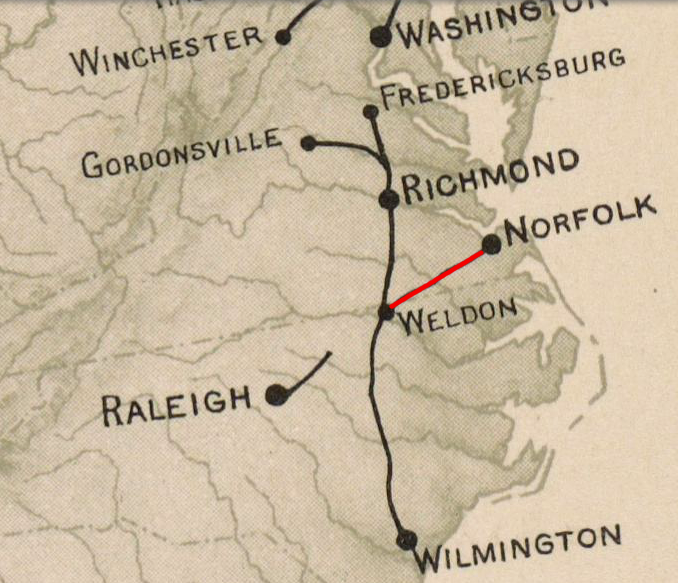
the Portsmouth and Roanoke Railroad offered an alternative to the Petersburg Railroad for transport of passengers to Baltimore and export of freight via the Chesapeake Bay
Source: Atlas of the Historical Geography of the United States, Railroads in Operation, 1840 (Plate 138L) digitized by University of Richmond
The competition stressed the finances of the Petersburg Railroad. In 1846, the competition with the Portsmouth and Roanoke Railroad was renewed after the railroad went through bankruptcy. Virginia's Board of Public Works bought it, and then leased it immediately to the town of Portsmouth. The business reopened as the Seaboard and Roanoke Railroad. Portsmouth purchased it from the state in 1847, then privatized the business again.
To restart operations in North Carolina, a new Roanoke Railroad was chartered in North Carolina. The Seaboard and Roanoke Railroad purchased the Roanoke Railroad in 1849. After the 17 miles of track was rebuilt between Weldon and the Virginia-North Carolina state line, full operations restarted in 1851.
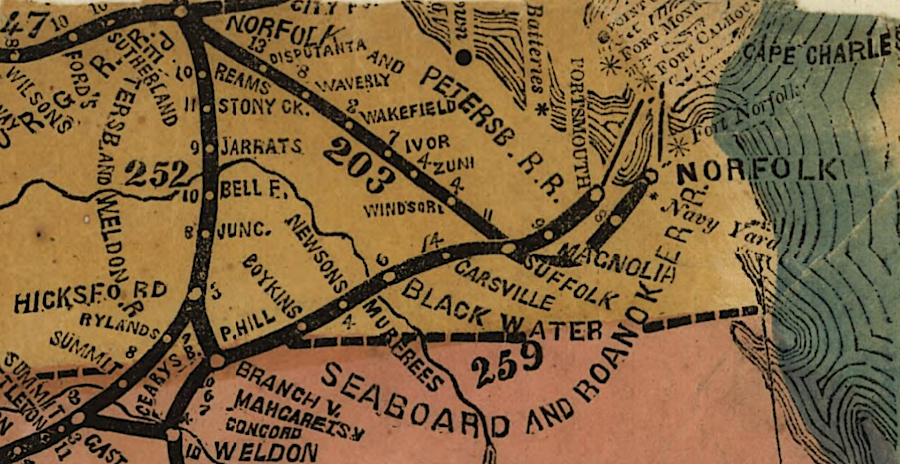
Seaboard and Roanoke Railroad in 1861
Source: Library of Congress, Lloyd's American railroad map (1861)
Business leaders based in Richmond, led by Moncure Robinson and financed by Philadelphia investors, acquired control of the Baltimore Steam Packet Company and then purchased the Seaboard and Roanoke Railroad. The Richmond business leaders already controlled the Richmond, Fredericksburg and Potomac (RF&P) Railroad. Acquiring the steamship company and the Seaboard and Roanoke Railroad gave the investors the ability to control prices for shipments headed north, preventing competition that would have eliminated profits.6
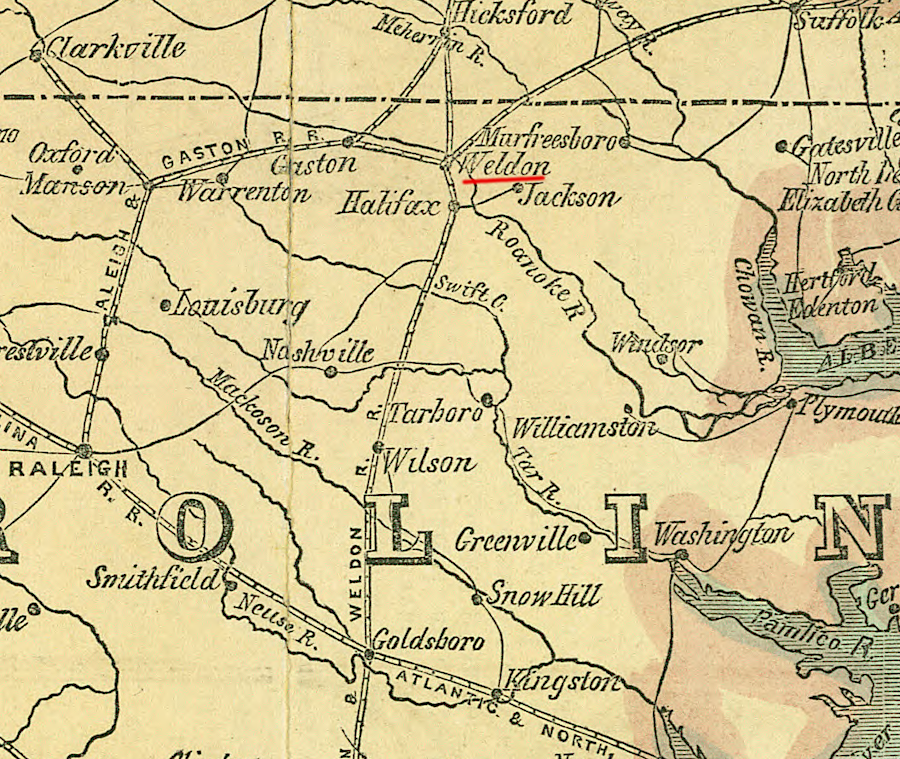
in 1861, the Seaboard and Roanoke Railroad connection to Weldon was key to getting traffic from the Piedmont to Portsmouth
Source: Library of Congress, Map of the southern states, including rail roads (Harpers Weekly, 1861)
In 1858, the Norfolk and Petersburg Railroad created a rail link between the Fall Line at the Appomattox River and the Chesapeake Bay port of Norfolk. The General Assembly's willingness to charter William Mahone's new railroad reflected another defeat of the Petersburg merchants who sought to use the power of state government to block competition. Virginia was never a purely capitalist economy, where businesses could operate independent of government oversight.
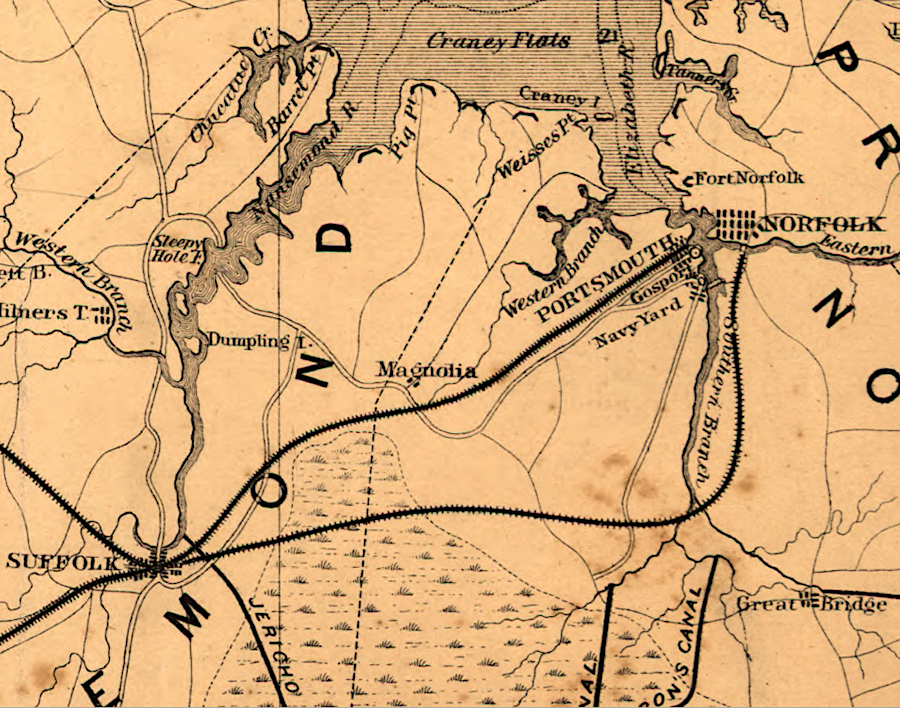
the Norfolk and Petersburg Railroad served the James River watershed, while the Seaboard and Roanoke Railroad catered to the Roanoke River watershed
Source: Library of Congress, E. & G. W. Blunt's corrected map of the seat of war near Richmond, July 10th, 1862
As railroads became essential public utilities after the Civil War, the legal interpretation by the North Carolina courts that the owners of a profitable Portsmouth and Roanoke Railroad could shut it down with no public constraint became unacceptable. The Roanoke & Tar River Railroad did manage a similar maneuver in 1893, however. It removed all the rails from its Murfreesboro Railroad secretly one night, avoiding a legal attachment of the property designed to require continued service.
Federal regulation of railroads started with passage of the Interstate Commerce Act in 1887 and creation of the Interstate Commerce Commission. The US Congress gave the Interstate Commerce Commission authority to regulate railroad rates, and to enforce those rates, in the Elkins Act in 1903 and the Hepburn Act in 1906.
In 1923, the Virginia State Corporation Commission (SCC), the successor to the Board of Public Works, ruled that even an unprofitable railroad could not cease operations by going through bankruptcy proceedings. The state agency forced the Marion and Rye Valley Railway to maintain service in 1923.
That demonstrated how government protection of essential transportation services, provided by private railroad corporations, had changed since the Petersburg Railroad tore up the track of the Portsmouth and Roanoke Railroad in 1844. The State Corporation Commission said clearly:7
- To permit a discontinuance of service by a railroad corporation at the arbitrary caprice or whim of the owners and without regard to the interest of that portion of the public which it serves is now unthinkable.
In 1846, the state's purchase of the Portsmouth and Roanoke Railroad eliminated the ability of the Petersburg investors to sabotage operations again. With the support of Petersburg's rivals in Richmond and Hampton Roads, Portsmouth renamed it the Seaboard and Roanoke Railroad and put it back into operation.
The Seaboard and Roanoke Railroad gained title to the bridge over the Roanoke River at Weldon in 1851. In 1853, the Raleigh and Gaston Railroad built track to Weldon and connected there with the Seaboard and Roanoke Railroad. That gave shippers on the Raleigh and Gaston Railroad the option of sending cotton, tobacco, corn, wheat, lumber, and other freight east to wharves at Portsmouth on the Elizabeth River, in addition to going north via the Petersburg Railroad to reach the James River at City Point.8
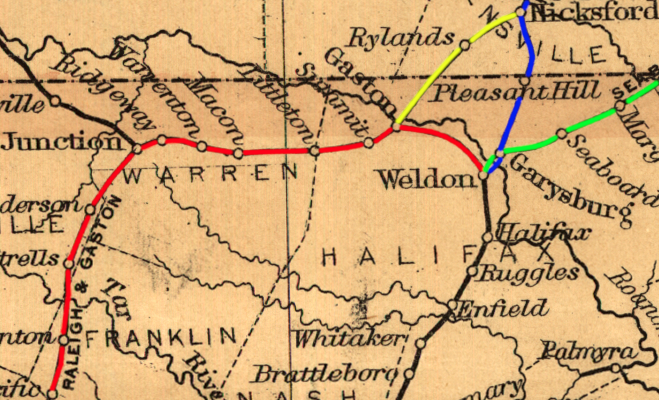
extension of the Raleigh and Gaston Railroad (red) to Weldon in 1853, with a connection to the Seaboard and Roanoke Railroad (green), created an alternative to the Greensville & Roanoke Railroad (yellow) and the Petersburg Railroad (blue)
Source: Library of Congress, Map of the Seaboard & Raleigh Railroad and its connections (1874)
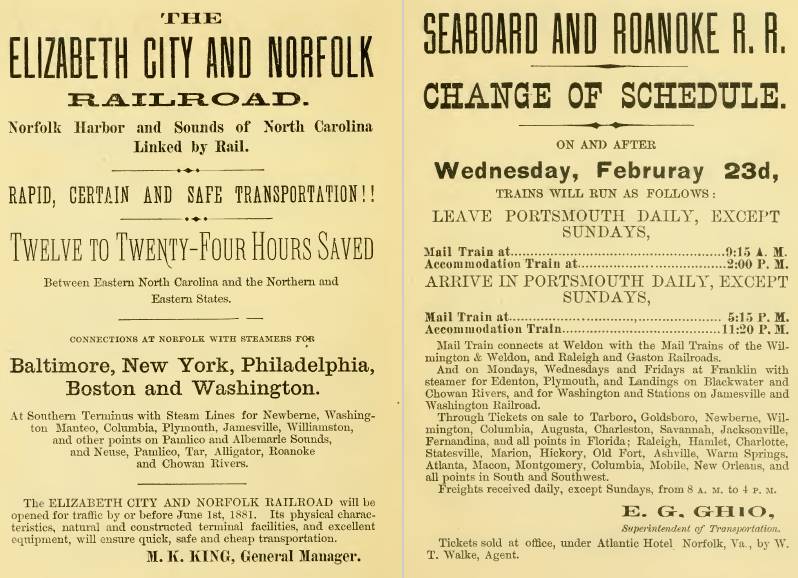
the Seaboard and Roanoke Railroad was operating in 1881
Source: Internet Archive, A history of Old Point Comfort and Fortress Monroe, Va., from 1608 to January 1st, 1881 (1881)
The restored link between Portsmouth and the Roanoke River provided effective competition. The Petersburg Railroad offered the "inland route" for passengers and freight, but the Seaboard and Roanoke Railroad provided an alternative way to reach the Chesapeake Bay. Passengers going north from Weldon could go to Portsmouth, catch a steamship at Hampton Roads, and get to Baltimore and points north.
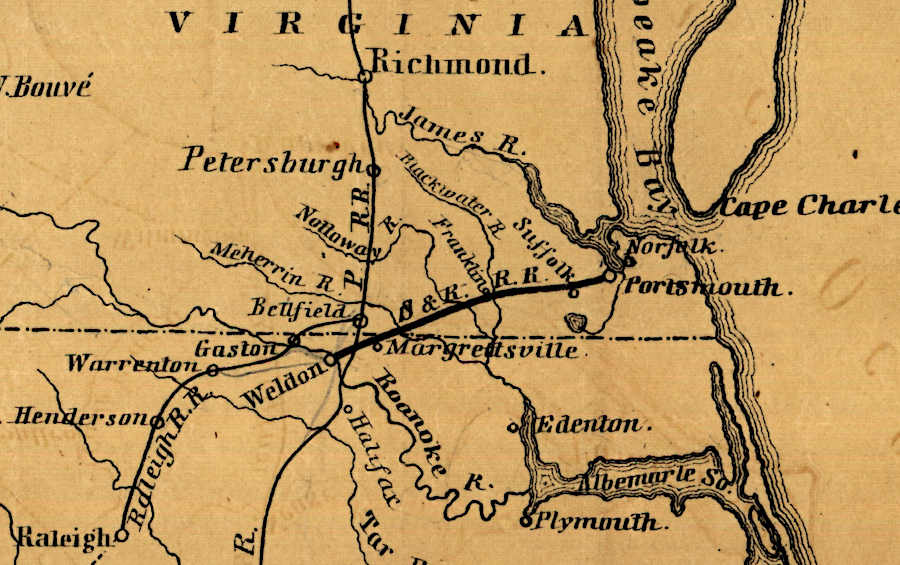
in 1847, the line linking Weldon and Portsmouth was called the Seaboard and Roanoke Railroad
Source: Library of Congress, Map of the Seaboard & Roanoke Railroad from Portsmouth, Va. to Weldon, N.C (by Ephraim W. Bouve, T. J Carter, 1847)
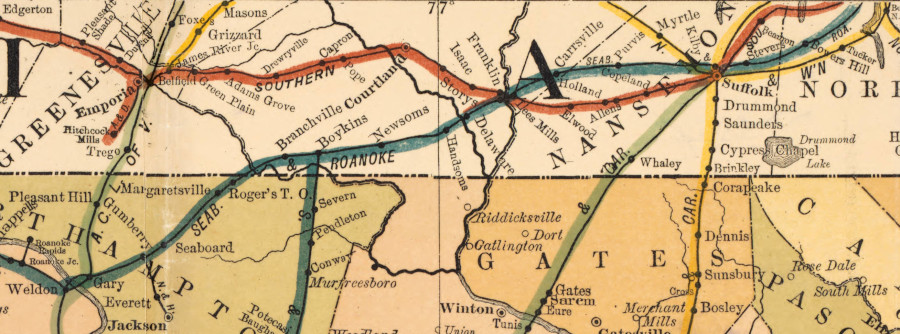
the Seaboard and Roanoke extended from Weldon east to Portsmouth in 1900
Source: University of North Carolina Libraries, Railroad map of North Carolina 1900 (by Henry C. Brown, 1900)
The Petersburg Railroad managed to build its own bridge across the Roanoke River in 1840, but both railroad bridges were destroyed in the Civil War. The Petersburg Railroad negotiated rights to use the Seaboard and Roanoke Railroad bridge in 1867. That continued after a flood washed out the bridge in 1875, until the "Petersburg Railroad" finally built its own in 1910-1912. At that point, the Petersburg Railroad had been incorporated into the Atlantic Coast Line, and the Seaboard and Roanoke Railroad had been incorporated into the rival Seaboard Air Line.
In 1873, the Seaboard and Roanoke Railroad was combined with the Raleigh and Gaston Railroad, but the two lines retained their separate identities. In 1881 they joined the powerful set of allied companies doing business as the Seaboard Air Line, including the Carolina Central Railroad, Raleigh and Augusta Air-Line, and Georgia, Carolina, and Northern Railroad.
Under the leadership of John Robinson, the informal alliance of separate railroads advertised a common through-rate. The Seaboard Air Line offered streamlined processing of freight and passengers between Atlanta and Portsmouth, plus steamship connections to New York City. When the Seaboard Air Line was formally incorporated in 1900, the Seaboard and Roanoke Railroad lost its separate corporate identity.
The rivalry between the original railroads leading to Portsmouth and Petersburg continued after the Civil War. The Portsmouth and Roanoke (Seaboard and Roanoke) Railroad became part of the Seaboard Air Line. The Petersburg Railroad and the Norfolk & Carolina Railroad became part of the competing Atlantic Coast Line. All were folded into the same corporation when the Atlantic Coast Line and the Seaboard Air Line merged in 1967 to create the Seaboard Coast Line railroad.
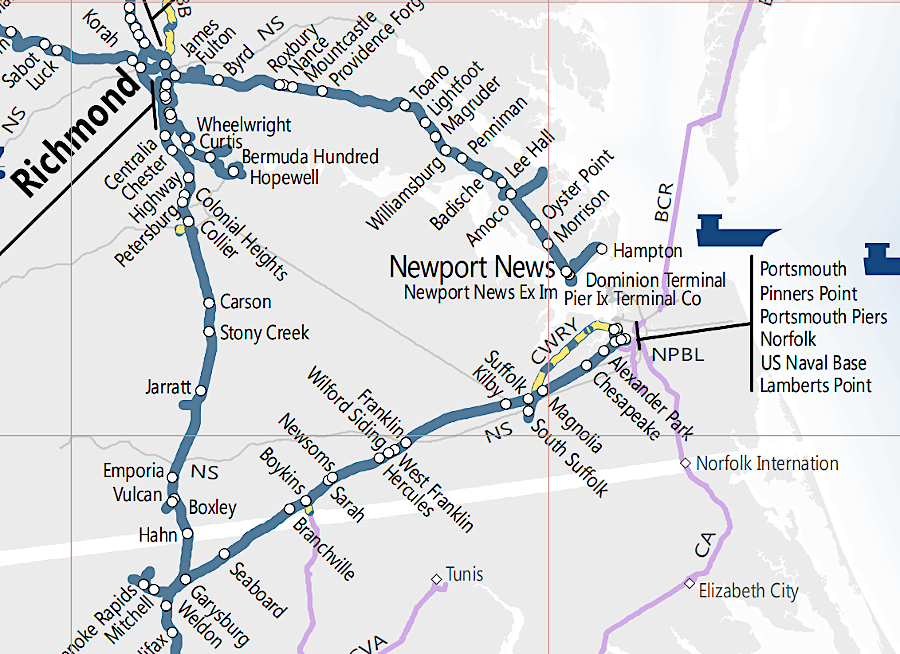
CSX now controls the routes of the original Portsmouth and Roanoke (Seaboard and Roanoke), Petersburg, and Norfolk & Carolina railroads
Source: CSX, CSX System Map
After the merger, only one railroad bridge was required to cross the Roanoke River. The bridge of the Seaboard Coast Line, at the site of the old Weldon Toll Road/Portsmouth and Roanoke Railroad bridge, was decommissioned and spans were removed.
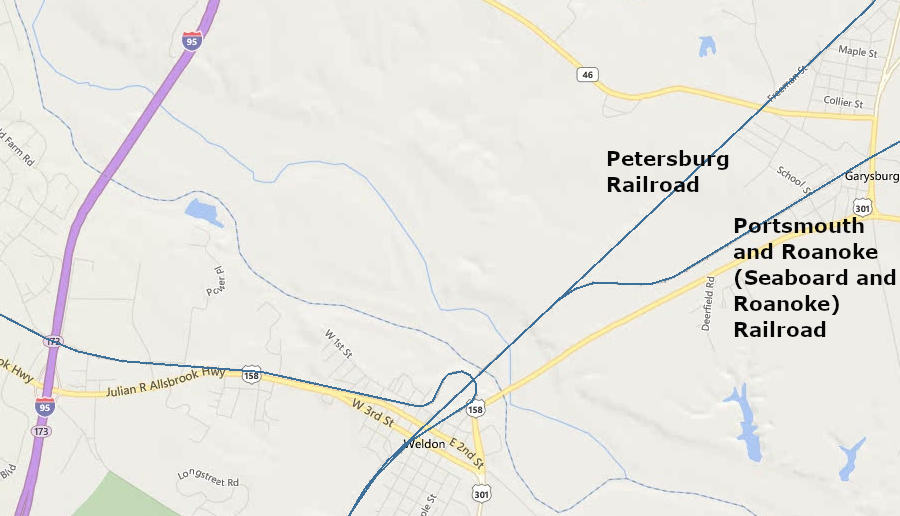
CSX retained the Petersburg Railroad bridge over the Roanoke River, and removed the bridge on the Portsmouth and Roanoke(Seaboard and Roanoke) Railroad route
Source: CSX, CSX System Map
Today, CSX uses the route of the old Portsmouth and Roanoke Railroad as its primary link to Hampton Roads south of the James River. CSX uses it to transport containers, primarily from the Portsmouth Marine Terminal (PMT) and Virginia International Gateway (VIG), to its mainline near Weldon. Trains cross the Roanoke River using the bridge built by the Atlantic Coast Line in 1910-1912.10
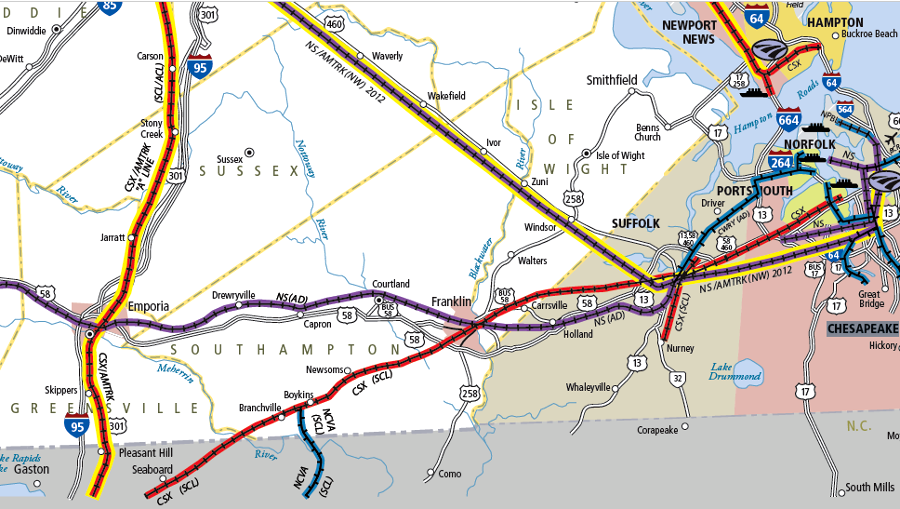
the line developed initially as the Portsmouth and Roanoke Railroad is now the modern route of the CSX (outlined in red), providing access to shipping terminals on the Elizabeth River
Source: Virginia Department of Rail and Public Transportation, Virginia
Railroad Map
Links
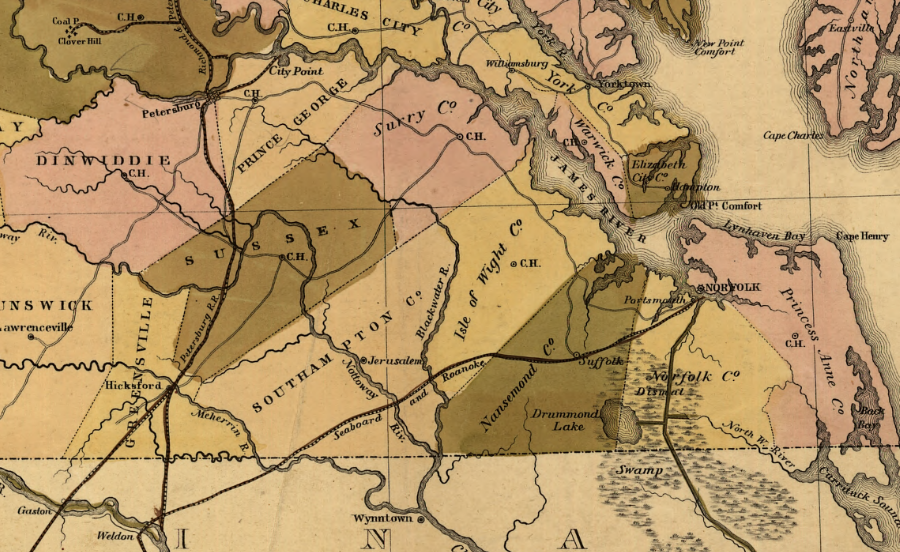
the Seaboard and Roanoke Railroad in 1848
Source: Library of Congress, A map of the internal improvements of Virginia (Claudius Crozet, 1848)
References
1. "North Carolina Railroads - Portsmouth & Roanoke Railroad," Carolana, http://www.carolana.com/NC/Transportation/railroads/nc_rrs_portsmouth_roanoke.html; "North Carolina Railroads - Seaboard & Roanoke Railroad," Carolana, http://www.carolana.com/NC/Transportation/railroads/nc_rrs_seaboard_roanoke.html; "North Carolina Railroads - Seaboard Air Line Railway / Railroad," Carolana, http://www.carolana.com/NC/Transportation/railroads/nc_rrs_seaboard_air_line.html; "North Carolina Railroads - Seaboard Coast Line Railroad," Carolana, http://www.carolana.com/NC/Transportation/railroads/nc_rrs_seaboard_coast_line.html; "Seaboard & Roanoke Railroad Company," Annual Report, Virginia, Railroad Commissioner, 1898, p.170, https://books.google.com/books?id=mCUaAQAAIAAJ; Richard E. Prince, Seaboard Air Line Railway: Steam Boats, Locomotives, and History, Indiana University Press, 2000, pp.5-8, https://www.google.com/books/edition/_/MM2ph3S2V2cC (last checked June 2, 2020)
2. Peter C. Stewart, "Railroads and Urban Rivalries in Antebellum Eastern Virginia," The Virginia Magazine of History and Biography, Volume 81 Number 1 (January, 1973), pp.4-5, http://www.jstor.org/stable/4247766; ; "Greenville and Roanoke Railroad," NCPHS Newsletter, Volume 10, Number 4 (Fall 1991), pp.6-8, http://www.ncpostalhistory.com/wp-content/uploads/2016/05/NCPHS_Journal-038-1991-Fall.pdf (last checked December 3, 2018)
3. Thomas C. Parramore, Peter C. Stewart, Tommy L. Bogger, Norfolk: the First Four Centuries, University of Virginia Press, 2000, p.162, https://www.google.com/books/edition/_/pWiCMTB35mEC; Peter C. Stewart, "Railroads and Urban Rivalries in Antebellum Eastern Virginia," The Virginia Magazine of History and Biography, Volume 81, Number 1 (January, 1973), p.5, https://www.jstor.org/stable/4247766 (last checked June 8, 2020)
4. "North Carolina Railroads - Portsmouth & Roanoke Railroad," Carolana, http://www.carolana.com/NC/Transportation/railroads/nc_rrs_portsmouth_roanoke.html; "North Carolina Railroads - Greensville & Roanoke Railroad," Carolana, https://www.carolana.com/NC/Transportation/railroads/nc_rrs_greensville_roanoke.html; Douglas A. Wait and John R. deTreville, "First Rail Lines and the Birth of the North Carolina Railroad," NCpedia, 2006, https://www.ncpedia.org/railroads-part-2-first-rail-lines; James C. Burke, "North Carolina's First Railroads, A Study in Historical Geography," PhD thesis, University of North Carolina at Greensboro, 2008, pp.2-3, p.5, p.32, pp.312-314, https://libres.uncg.edu/ir/uncg/f/Burke_uncg_0154D_10006.pdf; James C. Burke, The Wilmington & Raleigh Rail Road Company, 1833-1854, McFarland, 2011, p.24, https://books.google.com/books?id=Bc1dcgpEbZoC; George A. Kennedy, "Wilmington & Weldon Railroad," NCpedia, 2006, https://www.ncpedia.org/wilmington-weldon-railroad; "A History of Goldsboro, North Carolina," Carolana, http://www.carolana.com/NC/Towns/Goldsboro_NC.html; "The First Railroad Hub of the South - Weldon NC," Weldon, North Carolina, https://www.historicweldonnc.com/about-weldon-nc/68-the-first-railroad-hub-of-the-south-weldon-nc.html (last checked January 18, 2019)
5. Peter C. Stewart, "Railroads and Urban Rivalries in Antebellum Eastern Virginia," The Virginia Magazine of History and Biography, Volume 81 Number 1 (January, 1973), pp.6-7, http://www.jstor.org/stable/4247766 (last checked August 10, 2016)
6. "North Carolina Railroads - Portsmouth & Roanoke Railroad," Carolana, http://www.carolana.com/NC/Transportation/railroads/nc_rrs_portsmouth_roanoke.html; "North Carolina Railroads - Seaboard & Roanoke Railroad," Carolana, https://www.carolana.com/NC/Transportation/railroads/nc_rrs_seaboard_roanoke.html; Peter C. Stewart, "Railroads and Urban Rivalries in Antebellum Eastern Virginia," The Virginia Magazine of History and Biography, Volume 81 Number 1 (January, 1973), pp.10-13, http://www.jstor.org/stable/4247766; "Chapter 8: Historical & Cultural Resources," Moving Forward: The Comprehensive Plan for Chesterfield County, Chesterfield County, May, 2018, p.54, https://www.chesterfield.gov/documentcenter/view/2108; Richard E. Prince, Seaboard Air Line Railway: Steam Boats, Locomotives, and History, Indiana University Press, 2000, pp.7-8, p.17, https://www.google.com/books/edition/_/MM2ph3S2V2cC (last checked June 29, 2020)
7. "Commonwealth of Virginia ex rel. Virginia Table Company Incorporated wt al. v. Minnie E. Knight et al.," Virginia State Corporation Commission, Case Np. 1789, July 19, 1923, Public Utilities Reports, Lawyers Co-operative Publishing Company, 1924, pp.819-820, https://books.google.com/books?id=ZAUkAQAAIAAJ; "Hepburn Act," Teddy Roosevelt Center, https://www.theodorerooseveltcenter.org/Learn-About-TR/TR-Encyclopedia/Capitalism-and-Labor/The-Hepburn-Act; Richard E. Prince, Seaboard Air Line Railway: Steam Boats, Locomotives, and History, Indiana University Press, 2000, p.24, https://www.google.com/books/edition/_/MM2ph3S2V2cC (last checked June 29, 2020)
8. "North Carolina Railroads - Portsmouth & Roanoke Railroad," Carolana, http://www.carolana.com/NC/Transportation/railroads/nc_rrs_portsmouth_roanoke.html; "North Carolina Railroads - Seaboard & Roanoke Railroad," Carolana, https://www.carolana.com/NC/Transportation/railroads/nc_rrs_seaboard_roanoke.html; George Stevenson, Jr., "Gwynn, Walter," NCpedia, 1996, https://www.ncpedia.org/biography/gwynn-walter; Richard E. Prince, Seaboard Air Line Railway: Steam Boats, Locomotives, and History, Indiana University Press, 2000, p.8, https://www.google.com/books/edition/_/MM2ph3S2V2cC (last checked June 29, 2020)
9. "The First Railroad Hub of the South - Weldon NC," Weldon, North Carolina, https://www.historicweldonnc.com/about-weldon-nc/68-the-first-railroad-hub-of-the-south-weldon-nc.html; "The Roanoke River - Weldon, NC ," Weldon, North Carolina, https://www.historicweldonnc.com/about-weldon-nc/65-the-roanoke-river-weldon-nc.html; "North Carolina Railroads - Seaboard Air Line Railway / Railroad," Carolana, http://www.carolana.com/NC/Transportation/railroads/nc_rrs_seaboard_air_line.html (last checked January 18, 2019)
10. "Halifax County, NC," Bridgehunter, https://bridgehunter.com/nc/halifax/ (last checked May 16, 2020)
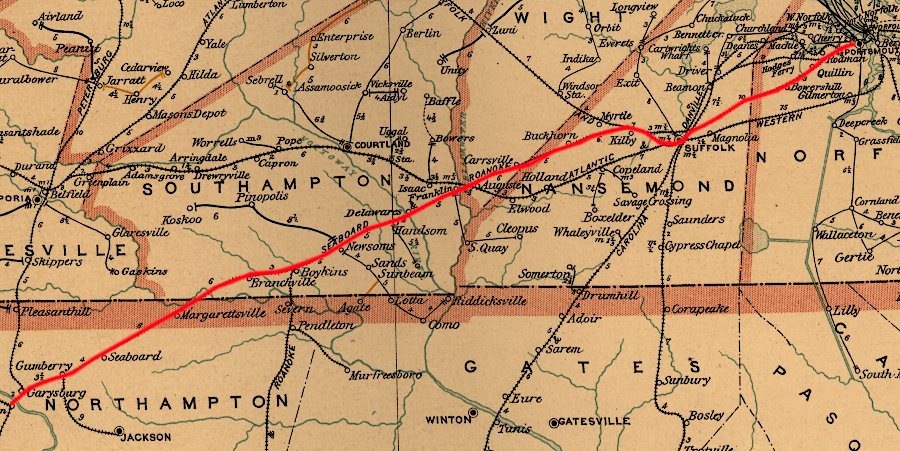
Seaboard and Roanoke Railroad in 1896
Source: Library of Congress, Post route map of the state of Virginia and West Virginia (1896)
Railroads of Virginia
Virginia Places




























